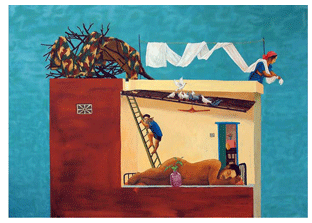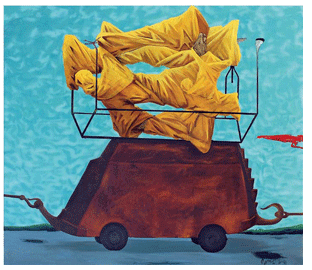- Prelude
- Editorial
- ...Where ever I stumble, let painting lie before me....
- ...Colour guides in its own direction...
- Abstract Art: Popular Myths and History
- Abstract Rhetoric:
- Ram Kumar: A transition from figurative to abstract
- I walk the line
- Exploring a twilight zone
- Articulating the Abstract voice from Madhya Pradesh
- Perception of Abstract in forms
- Confronting Cultures: The Dialectic of Abstraction in Bengal Art
- K.C.S. Paniker and his Words and Symbols
- Dialectics of Abstract Art and Its Indigenous Identity
- Between Ambivalence and Criticism: Why Abstraction?
- Notations and Rhythm in Space: Sushen Ghosh
- Victorian Era: Eclectic Furniture
- Patek Philippe : an overview
- The “Theme Pandals” of Durga Pujo: An Unexplored Discourse
- Musings on Music
- Butterflies in the stomach… still
- Contemporary Art Market Report 2009-10
- Artist Index and Statistics
- Auction Reports
- Recent works of Pavan kumar D. - In the Journey of Learning things
- Narrating “with a pinch of salt” Paintings of K.P.Reji
- Reclaiming an artist of true calibre
- Musings from Chennai
- An Annual Homage..
- Art Events Kolkata: September-October 2010
- Mumbai Art Sighting
- Art Bengaluru
- Unveiling the next in line
- Preview
- In the News
- Sotheby’s : Important Watches Hong Kong
ART news & views
Narrating “with a pinch of salt” Paintings of K.P.Reji
Volume: 3 Issue No: 10 Month: 11 Year: 2010
K.P.Reji's paintings are open commentaries about events and incidents which we encounter in our day to day lives. But these are events and incidents which are always outside the symbolic representation, pushed to the realm of the unknown or invisible. He attempts to make us remember what the real is through his representations. In that way they are confrontational in the everyday sense of the word. As he mentions his paintings are like a Hitchcock film where everyone knows what is about to happen but are helpless and have no option but to confront it.
|
His narrative is straight forward; but not linear. He utilizes heterogeneous space and time which brings in this non linearity. This bases itself in the anti hierarchical logic where the universal (timeless) get mingled with something which is transient. They are partners of a dialectic. He doesn't imitate or chronicle the reality as it's reproduced by the oppressive systems. Rather he creates his own self reflexive reality, thereby  refuses the essentialism of meaning and hence authority. One more interesting aspect of his work is the exposure of the violence interpolated in the intimate, private and innocent lives of the people.
refuses the essentialism of meaning and hence authority. One more interesting aspect of his work is the exposure of the violence interpolated in the intimate, private and innocent lives of the people.
He talks about the complex structures which governs our lives and keeps us under control- socially, politically and morally. He unites both personal and social. His idiom though appears to be surreal, is more about the absurdity of a commonsensical and practical existence. By this device of simultaneous coexistence he creates a language which is neither an objective documentation, nor a very self centric expressionism. His self is absent present in his story telling. Readers are captivated by simultaneous events, not what happens in same chronological time but rather in small details and in different characters, objects and also by dislocated fragmented time. His narrative approach is more tongue in cheek. The world he creates is neither ideal nor meaningless.
In his paintings tragedy and violence are shown not in a loud expressionism but as an ordinary occurrence. The painting 'birds' brings in this aspect. Referring to a chocolate advertisement and juxtaposing with a tragedy he pokes at the nullifying numbness of the popular representations which are part of our everyday thinking. In this context one would try to compare it with Iranian cinema (Kirostami, Makamalbaff) where serious and heavy emotions  are ironed out and an ordinary depiction of events and experiences are shown. The tragedy here is not loud and outpouring but realistic and happening.
are ironed out and an ordinary depiction of events and experiences are shown. The tragedy here is not loud and outpouring but realistic and happening.
The larger than life size stones placed over the houses in his series of paintings “just above my head” makes the real appears surreal. But as he tells they are really visuals which one could see in some quarters of any city. In his recent series 'pinch of salt' the periphery is shifted to the center. The peripheral characters who are generally pushed to the background, gets a self description and assertion in his paintings. The backdrop is the developmental structures of big cities and urban dwellings. These structures sometimes look as abstract forms and sometimes act as a threshold or space where things /objects are segregated as a strategy to play with varied spaces like inside /outside, public /private, sacred /profane, making two conflicting/opposing signifiers reside side by side. As in Giotto's paintings, architecture plays a major role in defining the structure of the paintings so does Reji's architecture defines the characters enclosed inside it.
In his earlier “love paintings” we can see existence of silence / gaps that creates a timeless ambience but not something of a metaphysical site beyond our comprehension rather are very much mundane experiences. His characters are generally those who had been forced to remain marginal in relation to dominant imperial culture. He seems to celebrate the simple details like “love” in his paintings. This can be seen as letting the self free from seriousness and are let lose to open up.
The postmodern dilemma is on us. “Family” represents a space where definite norms are set and differences are suppressed. In such a set up family takes as overtone of dominant structure becoming an oppressive unit. The subversive potential of romance, its ability to break down caste/class/religious barriers is what is attempted in his works.  It does not give scope of the middle class double talk of morality and freedom. His characters while playing their romance also transcend from their fixed positions within the system.
It does not give scope of the middle class double talk of morality and freedom. His characters while playing their romance also transcend from their fixed positions within the system.
In his series “pinch of salt” he talks about how violence is ingrained in our psyche form early childhood. They are subtly shown in one work titled “last floor” a boy is carting a cat towards a flock of doves in the ceiling or in another work titled “dinner” where a elderly looking child is killing a cockroach by yellow toy car. In the work “bad catch” a boy is killing a turtle to save the hook for further fish catching. The vegetation is in the shape of a map suggesting the politics of the world ordering. His works seems to draw influence from Balthus depiction of children. Reji uses child image as an allegory to talk about cold-bloodedness of violence in grained in us since childhood as is seen in Kim- Ki- Duk movie “summer winter”. The children's gaze in his work pokes fun at the adults who take voyeuristic pleasure.
There is also an artist's subtext of migration and displacement. In his early series “just above my head” displacement and migration was shown in a simple way. In recent series they are shown with signifiers like vehicles with objects of labour. Also he uses art historical signs like Ramkinkaer Baij's sculpture “Santal family” wrapped completely, only the head of the dog is seen. One can remember Chagall's mother and child image or cow in this context. In his series “Move the mountain” one sees this as evident subject. (Move the mountain is taken from Hitchcock's movie). He repeatedly uses the tools and belongings of the working class and the peasantry being on the move towards a different destination.
In another work titled “girl with a toy” he deals with the question of violence and internal displacement in Kashmir. There has been massive displacement of people and economic destruction of Kashmiri's during years of armed conflict. The background is a landscape with an army truck and jawans urinating. In the foreground a boy is urinating over the burning house.  In similar other paintings you can see similar instances where the landscapes are populated by jawans more than civilians. The girl in the painting “girl with a toy” is holding toy army man in her hand. Does it tell about how the army in modern days has been the tool of the political establishment and the bourgeoisie democratic system?
In similar other paintings you can see similar instances where the landscapes are populated by jawans more than civilians. The girl in the painting “girl with a toy” is holding toy army man in her hand. Does it tell about how the army in modern days has been the tool of the political establishment and the bourgeoisie democratic system?
Home is for a quite long time his obsessive image. There is nostalgia for dwelling a place of ones own. His installation pressure cooker is an allegory of house image. In his work architecture acts as an important element in defining the space and the characters. In this context one would try to remember what Heidegger says on modern technology.
”it is building which provides the location of dwelling. It is building which ceases the boundaries which allow us to know where we are and where we are going also who we are.”- Heidegger on dwelling …
Historically narrative language was inherent in Indian visual language. But the narrative as a conscious visual tool was taken up by the narrative group in Baroda. It became part of the pedagogical discourse with some of the group members being part of the faculty of fine arts, Baroda. Interestingly Reji's works shares both the tendencies of the narrative and the radical obsession of expressionism. His works can be in a way read as working in between these two poles of personalized narratives and serious expressionism.